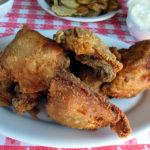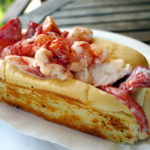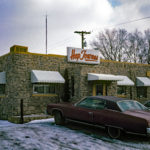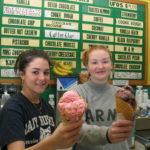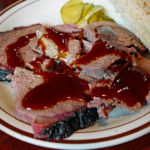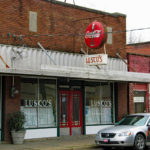Tioga Texas
In Texas in the late 1960s, wholesale garment salesman Warren Clark devised a shrewd tactic to lure buyers to the hotel room where he displayed his line of clothes. He brought a whole barbecued brisket and a whole smoked ham, which he had cooked himself at Sonny Bryan's restaurant in Dallas, back to his room and set them up on hot plates to keep warm. From out his open door, the powerful aroma of hot meats wafted through the hallways and into the elevators. Customers came to him in hordes and they ate plenty, but Mr. Clark didn't sell much merchandise because the clothes, sharing space with his fine barbecue, soon began to smell like smoke-house delicacies themselves. Still, Warren Clark didn't mind. He enjoyed sharing the food with friends and associates, and he particularly relished all the time he spent at Sonny Bryan's, where he devoted days to watching the master turn raw briskets into beef ambrosia.
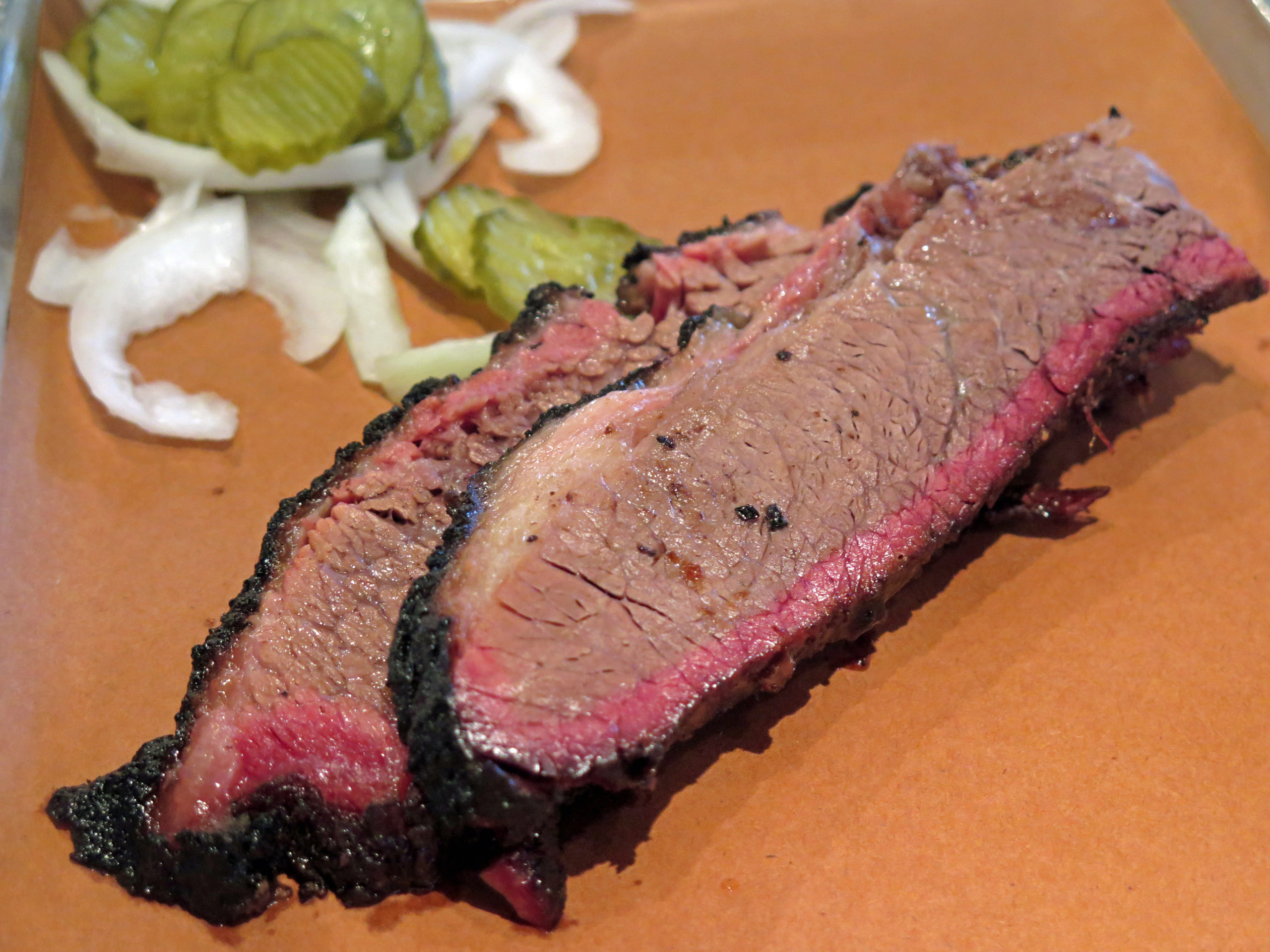
By Jane and Michael Stern
Originally Published 1998 Gourmet Magazine
In Texas in the late 1960s, wholesale garment salesman Warren Clark devised a shrewd tactic to lure buyers to the hotel room where he displayed his line of clothes. He brought a whole barbecued brisket and a whole smoked ham, which he had cooked himself at Sonny Bryan’s restaurant in Dallas, back to his room and set them up on hot plates to keep warm. From out his open door, the powerful aroma of hot meats wafted through the hallways and into the elevators. Customers came to him in hordes and they ate plenty, but Mr. Clark didn’t sell much merchandise because the clothes, sharing space with his fine barbecue, soon began to smell like smoke-house delicacies themselves. Still, Warren Clark didn’t mind. He enjoyed sharing the food with friends and associates, and he particularly relished all the time he spent at Sonny Bryan’s, where he devoted days to watching the master turn raw briskets into beef ambrosia.
A quarter century ago, when he realized his heart wasn’t in the clothing business, Warren Clark gave it up to pursue his dream: to live on the ranchland of northern Texas and run a barbecue restaurant like that of his mentor, Sonny Bryan. Since 1974, Clark’s Outpost, a good hour north of Dallas, has become a Lone Star legend, patronized by local horse breeders, city folk hungry for a country meal, flamboyant high rollers who arrive by helicopter in the field across the road, and good-food pilgrims from all over the U.S. in search of Texas on a plate.
Mr. Clark died a year ago, but his wife, Nancy Ann, carries on his enterprise with the resolve of a crusader on a sacred mission. As his partner for all those years, she knows exactly how to run the restaurant, which, although casual in the extreme and with service that appears haphazard, is, in fact, a precisely orchestrated gastronomic experience. Nothing about a meal at Clark’s Outpost is accidental. For example, barbecue sauce for the meat is presented in recycled Grolsch beer bottles—a seemingly offhand touch unless you note that the bottles are kept warm in a bain-marie until the moment they are served. Each rickety table, covered with yellow-checked oilcloth, is equipped with a three-bottle battery of accoutrements essential for enjoyment of Clark’s Wild West cuisine: hot sauce, pickled sport peppers, and wooden toothpicks.
Clark’s renown was built on beef, and, in the early days, that was nearly all there was on the menu, prepared the way Warren Clark learned by watching Sonny Bryan. “There are no secrets,” Sonny used to tell him. “There is just time. Time and smoke.” Briskets are put into smokers set over smoldering hickory or pecan wood (“Mesquite burns too hot; oak has a bad taste,” Nancy Ann explains), where they bask in the pungent smoke at 175 degrees for a few hours. The temperature is then turned down to a superslow 150 degrees, and the briskets cook for three days more. Nothing is put on the beef as it cooks—no seasonings, no sauces, no marinades. The trick is to have a hunk of brisket with a good layer of fat on top so that as the smoke drifts through it, drippings infuse every fiber of the meat. The result is elemental food: beef and smoke laced together in exquisite harmony that words cannot convey. Rimmed with a smoky black crust, each slice is so supple that the gentlest fork pressure separates a mouthful. The warm barbecue sauce, supplied on the side in those beer bottles, is dark, spicy, and provocatively sweet. Confronted with a plate of Clark’s beef and a bottle of sauce, we are inevitably thrown into a tizzy. The meat is so perfect that it seems wrong to embellish it in any way, and yet its luxury is increased by this fine sauce the way a fine painting is enhanced when surrounded by the right frame. We pour sauce on the plate and dip in the beef about every other bite.
Pork ribs are another of Clark’s treasures, cooked in wood smoke and served by the rack as a meal or cut into nuggets (rib ends) that make a truly appetite-inducing hors d’oeuvre. Neither tenderized nor marinated, the ribs are rubbed with seasoning mix and barbecue sauce and cooked until the meat between the bones is soft as filet mignon. Dinner-size orders arrive at the table with racks already severed into individual bones, each one lean and smoke-flavored, glistening with its own inherent juice but also begging for some of that good sauce. If you order ribs, you are provided with a moist, warm terry cloth “rib towel” to keep your face and fingers clean.
Also from the smokers come Polish sausages, hams, turkeys, and trout, each of which is available as a dinner, which means it is presented on a broad pewter plate with two vegetables, Texas (extra-thick) toast, a spiced peach half, a slice of raw onion, and a dill pickle spear. One of the few non smoked meals on the menu is skillet-cooked chicken-fried steak—a boneless sirloin pounded thin, dipped in egg and flour, and fried to a crisp. It is gently spiced in such a way that every single bite seems to tease the tongue; its savor is amplified by bacony “sawmill” gravy. Quail is another pan fried prize, the tiny, tasty birds encased in crunchy buttermilk batter. Clark’s offers a unique starter with the slightly oxymoronic name “jumbo quail legs.” About the size of chicken wings, these not-so-jumbo legs are big in flavor nonetheless—crusty and well seasoned, their dark meat incredibly luscious.
Nancy Ann, herself a refugee from the garment business, has become a fount of wisdom regarding Texas gastronomic ways. “Calf fries are a lost art,” she declares, referring to the tenderest part of a young male bovine—that old prairie delicacy euphemistically known as “prairie oysters” or, on jocular menus, “tender-groin.” Only one butcher in Fort Worth is good enough to supply calf fries fine enough to suit Clark’s standards. Clark’s cooks up about two thousand pounds of the delicate meat each year. Fried crisp, but meltingly soft inside, calf fries are a cattle-country treat served with rugged pan gravy on the side.
To go with platters of meat, Clark’s offers a slew of accompaniments ranging from classic crisp-fried okra and old-time red beans to jalapeno-spiked black-eyed peas and that marvelous oddity, french-fried corn on the cob. Lengths of corn, unbattered and unadorned, are dipped in hot oil about a minute or so, just long enough for the kernels to cook and begin to caramelize. The process yields corn that is quite soft, with a mere veil of a crust, and is astoundingly sweet. Each piece is served with horseshoe nails stuck in the ends to serve as holders. If you really like the taste of collard greens, you’ll love Clark’s. The heavy leaves are served in a glossy wet heap, so radiant with green-vegetable flavor that we invariably congratulate ourselves for our healthy eating habits as we fork them up.
In many otherwise exemplary roadhouse restaurants, dessert is merely an afterthought, at best. Not at Clark’s, though, where grand coconut and chocolate pies are made every morning by waitress Patt Seyler, who has perfected the art of building towering meringues more ethereal than clouds in heaven. “We need Patt because she is a seven-day-a-week piemaker,” Nancy Ann says. “You can’t serve yesterday’s meringue—it isn’t light the way meringue should be.”
Despite its success and renown, Clark’s has remained assertively rustic. Much of its charm is its location in the Red River country town of Tioga, the population of which has more than doubled since the restaurant opened—from 300 to 625. Still little more than a ranchland crossroads, Tioga’s ancient main street—named Gene Autry. Drive, in honor of its famous native son—consists of a tack shop, a realtor’s office, and a catfish parlor. Around the corner, at the junction of Gene Autry Drive and Highway 377, sits Clark’s, a small agglomeration of wood buildings surrounded by a gravel parking lot and stacks of wood for the smokers, with the flags of Texas and the U.S. flying above.
Nancy Ann recalls that when she lobbied Warren to let her convert the former grocery store next to the restaurant’s cramped quarters into another dining room, he agreed only reluctantly, warning her that he didn’t want to fluff it up and turn his place into some sort of ladies’ tearoom. Not to worry. Clark’s Outpost could never be described as ladylike. Its floors are uneven concrete, and, to keep the noise level low in the newer dining room, horse-blanket material has been strung along the tin ceiling just above exposed heating ducts. The decor is a hodgepodge of pictures, letters, and newspaper clippings, souvenir baseball caps, bleached cattle skulls, and Gene Autry memorabilia.
Although the barn board walls are plastered with testimonials and photos from adoring celebrities, ranging from supermodel Christie Brinkley to balladeer Red Steagall, most of the portraits on display are of famous quarter horses from surrounding farms—some in formal painted head shots, others going through their moves to win trophies in reining, cutting, and racing. Alongside the quarter horse heroes are photos and paintings of their trainers and owners; and on one wall hangs a handsome portrait of 1987 Kentucky Derby winner Alysheba, a Thoroughbred whose
jockey originally hailed from around here. But the most striking piece of decor at Clark’s is a mural that occupies one whole wall of the cavernous “new” dining room, about a hundred feet long and eight feet high. It was painted in 1991 by artist Rick Duwe, who depicted what appears to be a bunch of ranch hands and cowpokes around a campfire as herds of cattle graze in the distance behind them. To connoisseurs of New American cuisine, however, there is something familiar about the faces of these grizzled waddies. The one with the banjo is Dean Fearing; the one lounging on his sleeping bag is Stephan Pyles; there’s Robert Del Grande; and there’s Kevin Ascolese, too. These big guns of modern southwestern gastronomy are all frequent patrons and devoted friends of Clark’s.
“It’s the cat’s meow of barbecue,” Dean Fearing declares. “When I want to take an out-of-towner someplace Truly Texan, Clark’s Outpost is it. Wolfgang, Julia—they’ve all enjoyed the trip.” For Fearing, Clark’s is extra special. Warren was like a father to him, and on his first date with Lynae, now his wife, he drove to Tioga for supper. Dean recalls, “Mid-meal, Nancy Ann pulled me aside and whispered, ‘She’s a keeper, Dean. Marry her!’ ” This past February, Dean and Lynae named their first child Jaxson Clark Fearing, the middle name chosen to honor Warren and Nancy Ann.
For years eager entrepreneurs have tried to engineer a second location of Clark’s in California, New York, or inside the city limits of the Dallas/Fort Worth Metroplex, but Warren and Nancy Ann never gave such schemes a thought. “This place cannot be duplicated,” Nancy Ann says with unshakable conviction. “There can be only one Clark’s Outpost, and that is in Tioga, Texas, horse country, U.S.A. Where we are, north of Highway 380, it’s a brand-new world. We are friendly, we are relaxed, and, most of all, we are an easy place to come for supper. When you sit down here, you can be certain you’ll be getting something satisfying. Why, I’ve been to some restaurants in Dallas where the plate design is so beautiful and the portions so minute, you walk out wondering if you ate anything at all. We don’t do plate design at Clark’s. But we dang sure do beef.”
Clark’s Outpost
Discuss
What do you think of Tioga Texas?
Related Articles
Stroud’s
By Jane and Michael Stern Originally Published 1995 Gourmet Magazine Chicken...
The Lobster Roll Honor Roll
Maine is the only state in America that features a picture of cooked food on its license...
Meat-And-Three
A few years back, country singer Ray Stevens invited a New York friend to join him at one of...
Top 12 favorite Ice Cream Scoops
WITH THE EXCEPTION of the hot dog bun, there has never been an edible invention as...
Top 5 BBQ Restaurants | Western Kentucky
Get yourself to Western Kentucky for great BBQ I see the food shows on TV where...
Best restaurants in Greenwood, MS | Hot Licks Delta Style
Ever since we first ate margarine-sauced pompano at Lusco’s, in Greenwood,...

